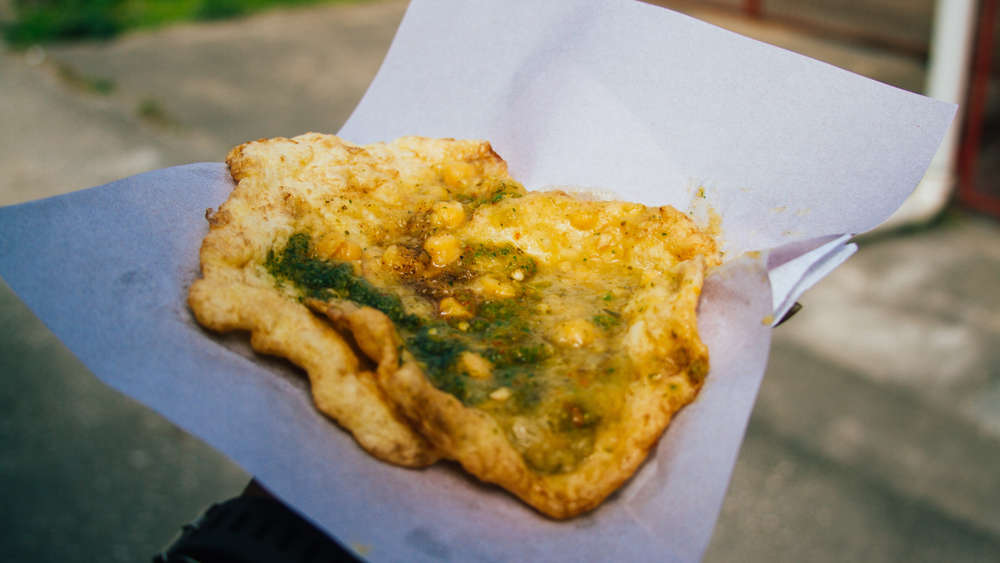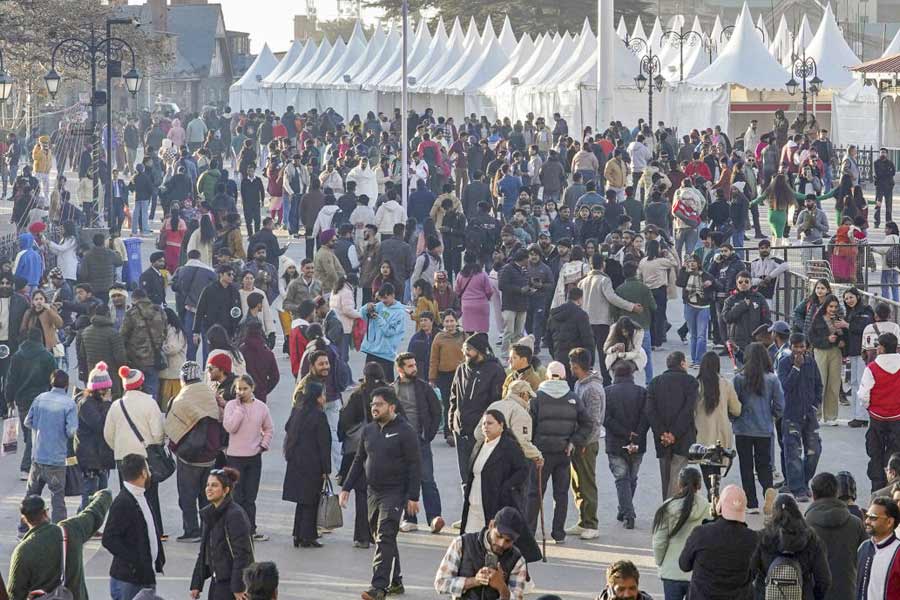“Where can I get doubles?” I asked a stranger while walking around Queen’s Park Savannah in Port of Spain on a Sunday morning. The stranger guided me to one corner of the park saying, “Usually you get doubles there till about 9 am.” As directed, I proceeded and found a vendor who was selling doubles. It was a small stall on wheels with “doubles for TT$ 5” printed on its body. I had to wait in a queue for a few minutes since there were customers before me. I asked for a doubles as my turn came. Hearing my English, which was without the touch of a Trinbagonian Creole, he looked at me and asked, “With chutney or without?” I did not know much about the ingredients in a doubles and didn’t want to miss any flavour. “With,” I replied.
As he prepared the food, I observed how he put the cooked chana or chickpea between two pooris and rolled it on a paper. As I unwrapped it and took a bite, I could taste cooked Indian chickpea curry, close to the ghugni style and something like poori or bhatura but not the same. Trinbagonians call this poori-like soft flatbread, bara. Besides the cooked chickpeas, the other ingredients included Caribbean chilli sauce and sweet mango pickle. The whole package was faintly sweet for my palate. It reminded me of the poori and chana that I had enjoyed as a boy in Sambalpur in Odisha, especially at the roadside shop in front of Gangadhar Meher College (now University) near Fatak railway station. Four pooris and cooked chana on a knitted sal leaf plate was a unique weekend attraction for students and travellers both for taste and affordability. The preparation of chickpea brought back the memory of ghugni in Ravenshaw College (now University) square in Cuttack. The chana preparation for a doubles is less spicy than ghugni. As is known, ghugni is a popular snack in the Indian subcontinent, especially in the eastern region of India. The chickpea, popularly known as kabuli chana in the subcontinent, is used for doubles. I am told that most of this chana is supplied from Canada, grown in the areas of Alberta and Saskatchewan. The use of either saffron or turmeric gives the bara a light yellow colour.
“Have you tried our doubles, High Commissioner?” was one of the questions that often crept in during my conversation with guests and visitors in Trinidad and Tobago in the early months of my arrival in Port of Spain. “Do you have doubles in India?” I was asked sometimes. After getting a taste of the Trinidadian doubles, I could frame an answer, “Not exactly, but something similar is the poori-chana or chole-bhature. Though the bhatura in North India has grown in size over the years.”
Doubles is a signature street-side breakfast in Trinidad and Tobago. In some places, it can also be eaten as an afternoon or late-night snack. Over the last eight decades, it has grown to become a Trinbagonian national cultural identity, cutting across ethnic and racial barriers. It has also crossed geographical boundaries. Presently, doubles is available in London, New York City, Toronto, Winnipeg, Miami and Tokyo.
The doubles has a history rooted in indentureship in Trinidad and Tobago. A total of 1,43,939 indentured labourers from India came to this land between 1845 and 1917 out of which about 14 per cent were Muslims. Mamoo Deen, who is credited with having introduced doubles to the colonial Trinbagonian community in 1936, is part of this history. According to the book, Out of the Doubles Kitchen: A Memoir of the First Family of Doubles — The Number One Street Food of Trinidad & Tobago, written by Badru Deen, one of Mamoo Deen’s sons, his ancestors hailed from Uttar Pradesh in pre-independent India. The exact place in Uttar Pradesh is lost in migration history. ‘Mamoo’ Deen means ‘Uncle’ Deen in Hindi. However, the actual name could have been Imam-ul-Deen, and the British officer could have registered the name as Mamoo Deen as he heard it. According to Badru Deen, Mamoo Deen was born on January 22, 1917 and died on March 13, 1979.
It is believed that before doubles, Mamoo Deen sold fried chana wrapped in cone-shaped paper in front of cinemas and colleges and improved it by adding a cooked variety. He then introduced a single bara with the curried chana cooked by his wife. Subsequently, customers, especially college students, asked him to make it a ‘double’ by adding a second bara over the chana. Thus came the name, doubles. Subsequently, Deen’s two sisters were married to the two Ali brothers, and the Deen-Ali family business expanded. According to one grandson, Araby Ali, who runs the Araby Ali’s Doubles Ltd. in Barataria in Trinidad, his ancestors were the ‘Bengali miyan’ of colonial India.
Today, besides the Deen and Ali family outlets, many other vendors sell doubles across the Caribbean and outside. They usually sell them out of boxes. A few stalls fry their baras in makeshift kitchens in the back of pick-up trucks. However, the chana continues to be prepared in home-based kitchens.
Many Trinbagonian cuisines have an Indian connection. Roti shops are omnipresent where one can buy one’s lunch. Dal and white flour are two crucial ingredients in these recipes. Since the indentured labourers from India did not bring wheat flour or atta, they used white flour supplied from Europe. Therefore, the roti one gets in roti shops here is made of white flour and not atta. The other household food are baigini, sahina, dhal puri, tarkari and chokha. Ever since the day I was treated to chokha, I had been wondering where did the litti go, leaving the chokha lonely. Gradually, I came to know that since the atta could not come with the indentured labourers, only the chokha had arrived, leaving the litti behind to keep the Chhath festival celebrations going in India.










